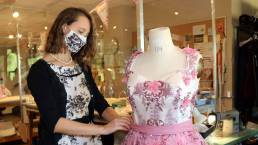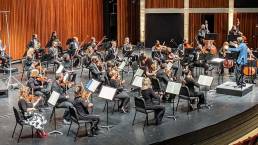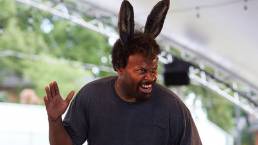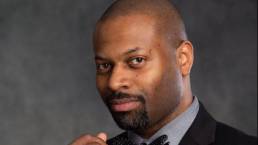Densil McFarlane performing at River & Sky. Photo: Jess Joly.
‘My first show back’: Performing artists talk about returning to Ontario stages
By: Chris Hampton
10 Nov, 2021
There’s a certain magic to the performing arts. People gather to experience the creative act live as it happens. There’s chance, there’s vulnerability and there’s the potential for something miraculous to happen. Unfortunately, the same qualities that make the performing arts so special — closeness, togetherness, presence — have also made them so difficult to practice during the COVID-19 pandemic.
For the producers of live music, theatre and dance, an unpleasant motto emerged that’s defined their predicament: “first to close and last to open.” COVID has been damaging across the arts and culture industry, but it’s been especially stifling for workers of the performing arts sector for whom there was no good alternative to conduct their livelihood.
Thanks to a highly vaccinated population, however, live events are safely resuming. Indoor music venues just got the green light to hold unseated shows at full capacity. Even if it is a hesitant return, as we navigate shifting passport and masking protocols, it is a happy one. For audiences, this might mean catching a matinee performance with the family or seeing your favourite band with some friends. But as an arts professional — on, behind or in front of the stage — it means finally getting back to work.
Ontario Culture Days spoke with a Shakespearean actor, an orchestra concertmaster, a theatre wardrobe specialist and the singer of a punk rock band about the hiatus, returning to the stage and what it means to finally be back.


Densil McFarlane, guitarist and lead singer of the OBGMs
Loud, sweaty and sparking with electricity, the OBGMs are known for their live show. In a good year, the Toronto-based punk rock band might play 100 concerts. And after spending much of 2019 writing and recording, the group thought they’d spend 2020 on the road for twice as many dates. But the very day they played their album release party, Tom Hanks announced that he had COVID-19 and the NBA suspended its season. Within days, all venues closed and the band’s big rollout plans were put on ice.
Immediately, guitarist and vocalist Densil McFarlane began researching pandemics — how long could this thing possibly last? When reports suggested anywhere from one to five years, he thought, “I’m going to have to find some way to keep the story alive for us.” So McFarlane bought a camera and taught himself to make music videos. If their high-flying live show was grounded, the band needed some way to share their message and their art.
Sixteen months after that album launch letdown, the OBGMs returned to the stage this past July, headlining the final night of River & Sky in Field, Ont., about an hour outside Sudbury. “Up until the day it happened,” McFarlane remembers, “I was unsure if it was going to happen.” The music and camping festival took place the first weekend Ontario entered Phase 3 of its reopening plan and was one of the province’s first such live events permitted to happen. Attendees had to provide proof of vaccination for entry as well as take a rapid test at the gates.
McFarlane says he was anxious at first. “Like, whoa, you guys are real close to me … but it’s like riding a bike.” And by the end of the show, the OBGMs’ trademark live routine was back and humming with McFarlane moshing along in the crowd. “I’m happy that we were able to be part of that,” he says, “of allowing people to feel close again.”
Another sign the gigging world is getting back up to speed: The band just announced a 22-show tour beginning March 2022. It’s not yet 100 or 200 dates, but it’s a good start.

Morgan Mackintosh, wardrobe cutter at Shaw Festival
For 14 seasons, Morgan Mackintosh has been a cutter in the wardrobe department at Niagara-on-the-Lake’s Shaw Festival — one of the world’s leading repertory theatres. It’s her job to draft the patterns that will transform the costume designer’s 2D sketches into a garment fit specifically for the actor’s body. Her work typically begins many months before the curtains first raise and finishes on opening night, when the wardrobe hits the stage (but if any of the costumes require a significant fix during the production run, that’s her job, too). “In a typical season, I probably build 30 to 40 costumes from scratch,” she says.
When Shaw closed for COVID, Mackintosh and the wardrobe department spent the remainder of the 2020 season working from home. Of course, they weren’t making live theatre, so their assignment was to help with the PPE shortage. Her team made 1,200 gowns and 2,000 masks for the community.
In March 2021, once the third lockdown was lifted, Mackintosh re-entered the work room (newly partitioned with Plexiglas) to begin the wardrobe for Sherlock Holmes and the Raven’s Curse, which would open in July. This was a much longer build time than usual, but with fewer hands contributing because of reduced capacity for social distancing.
As Shaw readied the production, Mackintosh noticed signs that familiar life was returning bit by bit. In June, for example, all rehearsals were required to be outdoors, and she remembers eating her lunch, listening to the orchestra play a piece start to finish. “We applauded because it was amazing to hear,” Mackintosh says, “then we all burst into tears because it was the first time something felt normal again.” She was similarly overwhelmed during a tech run, when halfway through she realized how incredible it was that she was inside a theatre watching a show. And once more, during previews, when a live audience first took the seats. “That was so exciting to see. It really felt like we were making huge progress.”
Now, as the cutter prepares Shaw’s Christmas show Holiday Inn, Mackintosh says that it seems like the theatre has found a rhythm. “It’s starting to feel more and more like the train is moving in the same direction that it used to be.”

Stephen Sitarski, concertmaster with the Hamilton Philharmonic Orchestra
Stephen Sitarski began violin at 4 and was playing professionally by his mid-teens. For the past nine seasons, the Kitchener native has been the concertmaster of the Hamilton Philharmonic Orchestra. That’s the title given the leader of the first violins. The concertmaster’s duties include leading the orchestra in tuning, making technical decisions for the strings and relaying cues from the conductor.
But for the HPO’s first show back, the concertmaster was passed another honour — the baton. In late September, a year and a half since the orchestra’s last public performance, Sitarski assumed the role of conductor for a free concert to welcome Hamilton back to the concert hall. He calls the programme “friendly” for the audience and orchestra both. “You’re talking about musicians who haven’t performed a live event in a year and a half,” he explains.
Rehearsals were a little rough, but then the players began finding each other, connecting and blending just as they used to. “It was thrilling,” he says. From his new position in front of the orchestra, he could see the smiles. Some people had tears in their eyes because it was so emotional.
“It’s one of the few professions,” Sitarski says, “where we say ‘I play the violin’; I don’t work the violin. To me, we’re players and we need to play together, which means there’s this sort of joyous interaction between people from different backgrounds and races and genders and whatever, but we find this common ground in ensemble music … it’s a magical thing.”


André Sills, Stratford Festival actor
André Sills began acting as a child in his church’s Christmas and Easter productions. The whole purpose of the church, he says, was to touch people’s hearts. “And I guess I realized at a young age that theatre can do that, too.” To this day, he’s attracted to work that challenges minds and pulls at the heartstrings.
When the actor was cast as Nick Bottom in Stratford’s A Midsummer Night’s Dream — the renowned rep theatre’s first live, in-person show since 2019 — Sills moved to the small Perth County city in preparation. But the same week rehearsals were to begin, Ontario introduced its three-step reopening plan, and under Phase 1, in-person rehearsals were not permitted. So the cast began read-throughs, text work, choreography and puppet workshops all via Zoom. After three weeks stuck online, live rehearsals were permitted, but only outdoors. And, on the first day, a thunderstorm blew down the tent they were performing under. “As for omens,” Sills says, “it didn’t look good.”
But when rehearsals moved into Stratford’s new outdoor stage, the Tom Patterson Theatre Canopy, the production found its groove. Sills says he doesn’t get nervous (because if he’s nervous he feels like he’s not ready), but after being away so long, coupled with the unorthodox rehearsal process, once the public hit the seats, “it was a bit of a rush.” There was a moment he remembers after his very first scene, when he came off to the corner of the stage to help with sound effects and he peeked into the audience. He saw their faces light up, watching the stick puppets who’d taken up the main action. “That set my heart at ease,” he says. “I realized that they were indeed there with us and just so happy to be back at the theatre.”
Chris Hampton is an arts and culture writer based in Hamilton. His work has appeared in Canadian Art, The Walrus, The Globe and Mail, Toronto Star, CBC Arts and The New York Times.
